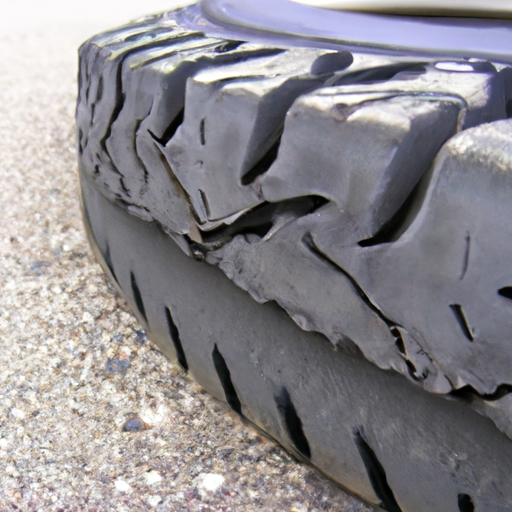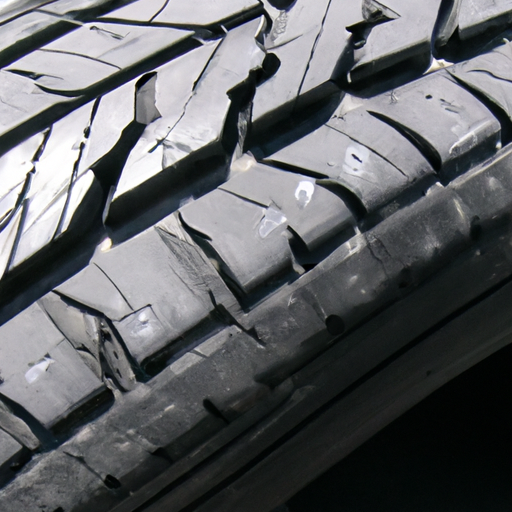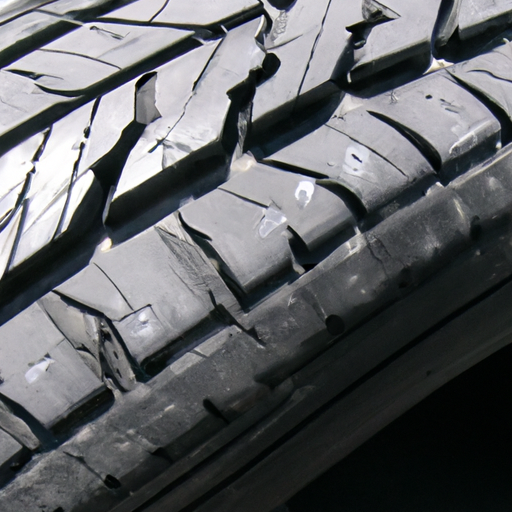Have you ever wondered how to identify tire sidewall damage? Well, look no further! In this article, we will explore the various signs of tire sidewall damage and guide you on how to spot them. Whether it’s a cut, bulge, or bubble, we’ll help you recognize the warning signs and take the necessary steps to ensure your safety on the road. So, let’s get started and become experts at identifying tire sidewall damage!

Understanding Tire Sidewall Damage
Introduction to Sidewall Damage
Hey there! In this article, we’ll delve into the details of tire sidewall damage and why it’s crucial to identify such issues on your tires. Your tire’s sidewall, the part between the tread and the bead that rests on the rim, is its first line of defense against external forces. It not only provides support and stability but also protects the inner structure of the tire. Being aware of the common causes, conducting visual inspections, monitoring tire pressure, seeking professional help when necessary, and following proper maintenance practices are all key to preventing and addressing sidewall damage.
Importance of Identifying Sidewall Damage
Taking proper care of your tires is vital for your safety on the road. Identifying sidewall damage is essential for two primary reasons: safety and cost-effectiveness. By detecting any signs of sidewall damage, you can address the issue before it escalates and potentially leads to a tire blowout or compromised handling. Additionally, addressing sidewall damage promptly can save you from costly repairs or even the need for premature tire replacement. So, let’s dive into the common causes of tire sidewall damage!
Common Causes of Tire Sidewall Damage
Potholes and Road Hazards
One of the leading causes of sidewall damage is encountering potholes and other road hazards such as debris, sharp objects, or uneven surfaces. Hitting a pothole or running over an object can cause the sidewall to flex beyond its limits, resulting in bulges, cuts, or tears. Additionally, road hazards can lead to impact damage, weakening the sidewall’s structural integrity over time. Avoiding such hazards or driving cautiously when encountering them can significantly reduce the likelihood of sidewall damage.
Curbing and Impact
Another common cause of sidewall damage is curbing or striking a curb while parking or maneuvering. The force of the impact can cause cuts, tears, or sidewall bulges. It’s essential to be mindful of curbs, especially when parallel parking or making tight turns. Being a little extra careful can save you from potential sidewall damage and ensure the longevity of your tires.
Age and Dry Rot
Tire sidewalls are also susceptible to damage due to age and dry rot. Over time, exposure to the elements, such as heat, UV rays, and harsh weather conditions, can cause the rubber to deteriorate. This degradation leads to cracks, splits, and weakened sidewalls. Regularly inspecting your tires, especially as they age, can help you catch any signs of dry rot and address them proactively.
Over/Under-inflation
Maintaining the proper tire pressure is crucial for tire health, performance, and safety. Both over-inflation and under-inflation can impact the sidewall and lead to damage. Over-inflation puts excessive stress on the sidewall, making it more susceptible to bulges, blisters, or even bursting. On the other hand, under-inflation causes the sidewall to flex excessively, leading to sidewall cuts, tears, and uneven wear patterns. To avoid sidewall damage, make sure you regularly check and maintain the recommended tire pressure levels specified by the manufacturer.
Extreme Heat or Cold
Extreme temperatures can have adverse effects on your tire sidewalls. High temperatures, especially during summer months, can cause the rubber to degrade and make the sidewalls more vulnerable to cracking or blistering. Similarly, extremely cold temperatures can make the rubber brittle, increasing the likelihood of sidewall damage. If you live in an area with extreme weather conditions, be extra vigilant when inspecting your tire sidewalls and consider using specialized tires designed for such climates.
Visual Inspection of Tire Sidewall
Checking for Bulges or Blisters
To identify sidewall damage, start by visually inspecting your tires regularly. Look out for any bulges or blisters on the sidewall. Bulges are raised areas and are often an indication of internal damage, such as a broken belt. Blisters, on the other hand, are air pockets that form within the sidewall due to inconsistencies during the manufacturing process. Both bulges and blisters require immediate attention and professional inspection or tire replacement.
Looking for Cuts or Tears
Inspect the sidewalls thoroughly for any cuts or tears. These can occur due to road hazards or curb impacts. Cuts may be visible on the surface, while tears might extend deeper into the sidewall layers. If you notice any cuts or tears, it’s essential to seek professional assistance to determine the severity of the damage and undertake the necessary repairs.
Inspecting for Sidewall Cracks
Look for any cracks on the sidewalls. These can occur due to age, dry rot, or exposure to extreme temperatures. Cracks are visible lines or fissures that occur in the rubber. They weaken the sidewall and can lead to sidewall failure if left unaddressed. Regular inspection can help you catch cracks early and take appropriate action.
Observing for Uneven Wear Patterns
Another important aspect of visual inspection is checking for uneven wear patterns on the sidewall. Under-inflation, over-inflation, misalignment, or suspension issues can result in uneven wear. An irregular or inconsistent tread pattern on the sidewall is an indication of potential problems. If you notice any signs of uneven wear, have your tires balanced, and aligned by a professional to prevent further damage.
Tire Pressure and Sidewall Damage
Effects of Over-Inflation
Now, let’s talk about the relationship between tire pressure and sidewall damage. Over-inflating your tires can put excessive stress on the sidewall. The increased internal pressure causes the sidewall to bulge outward or develop blisters. These weakened areas of the sidewall can fail unexpectedly, leading to a blowout or loss of control while driving. It’s crucial to maintain the recommended tire pressure to prevent over-inflation and avoid unnecessary sidewall damage.
Effects of Under-Inflation
On the flip side, under-inflation can also have detrimental effects on your tire sidewalls. Insufficient air pressure causes the sidewall to flex excessively while driving, leading to cuts, tears, and even separation of the plies. Under-inflated tires are more prone to damage from road hazards and are at a higher risk of sidewall failure. Regularly monitor your tire pressure and inflate accordingly to protect your sidewalls from the adverse effects of under-inflation.
Optimal Tire Pressure Levels
To keep your tires and sidewalls in optimal condition, it’s crucial to maintain the recommended tire pressure levels specified by the vehicle manufacturer. Proper tire pressure ensures adequate contact between the tread and the road, promotes even wear, and minimizes the risk of sidewall damage. You can find the recommended tire pressure range in the owner’s manual or on a sticker inside the driver’s doorjamb or gas cap cover. Regularly check your tire pressure with a reliable pressure gauge and adjust as necessary.

Professional Inspection and Repair
When to Seek Professional Help
While visual inspections are essential, some sidewall damage requires the expertise of a professional. If you notice significant sidewall bulges, blisters, deep cuts or tears, severe cracks, or any other signs of extensive damage, it’s crucial to seek assistance from a qualified tire technician. They can conduct a thorough inspection, assess the extent of the damage, and recommend appropriate repair techniques or tire replacement if necessary.
Proper Repair Techniques
When it comes to sidewall damage, there are limits to what can be safely repaired. Sidewall repairs are generally not recommended, as they compromise the tire’s structural integrity. Repairs are mainly limited to the tread area, where there is less stress and load. However, for minor sidewall damage, a professional technician may choose to use a patch or plug system to provide temporary support and prevent further damage until a replacement tire can be obtained.
Considerations for Tire Replacement
In some cases, sidewall damage may be severe or extensive enough to warrant tire replacement. Factors such as the age of the tire, the depth and location of the damage, and the overall condition of the sidewall will influence the decision to replace the tire. It’s important to follow the recommendations of a tire professional to ensure your safety on the road. Remember, investing in a new tire is a small price to pay for peace of mind and roadworthiness.
Preventing Tire Sidewall Damage
Proper Tire Maintenance
Proper tire maintenance plays a critical role in preventing sidewall damage. Regularly check your tires for signs of wear, perform visual inspections, and keep them properly inflated. Additionally, follow the manufacturer’s recommendations for tire rotation and balancing to ensure even wear and optimal performance. By being proactive and taking care of your tires, you can significantly reduce the risk of sidewall damage.
Avoiding Road Hazards
While it may not always be possible to avoid road hazards altogether, driving cautiously and avoiding known problematic areas can help prevent sidewall damage. Stay vigilant, especially on poorly maintained roads, and drive carefully when encountering potholes, debris, or uneven surfaces. Slowing down and steering clear of curbs when parking or turning can also minimize the risk of curb-related sidewall damage.
Regularly Checking Tire Pressure
Maintaining the proper tire pressure is crucial not only for sidewall health but also for overall tire performance and fuel efficiency. Regularly check your tire pressure using a reliable gauge and inflate them to the recommended levels. Keep in mind that your tire pressure can fluctuate with changes in ambient temperature, so it’s important to monitor and adjust accordingly.
Rotating and Balancing Tires
Uneven wear patterns can put stress on your tires’ sidewalls, leading to damage over time. To promote even wear and extend the lifespan of your tires, follow the recommended tire rotation intervals. Additionally, have your tires balanced regularly to ensure proper weight distribution and minimize vibration, which can also impact sidewall integrity.
Replacing Tires When Necessary
No matter how well you maintain your tires, there will come a time when they need to be replaced. As tires age, their rubber compounds deteriorate, making them more prone to sidewall damage. If your sidewalls show signs of cracks, bulges, or other irreparable damage, it’s essential to replace them promptly. Remember, safety should always be your top priority.
Safety Concerns
Potential Risks of Driving with Damaged Sidewalls
Driving with damaged sidewalls can have serious safety implications. The sidewalls provide critical support and maintain the tire’s structural integrity. When compromised, they can lead to hazardous situations on the road. It’s essential to understand the potential risks associated with driving on damaged sidewalls to prioritize prompt inspection and necessary repairs or replacements.
Impacted Handling and Stability
Sidewall damage can impact your vehicle’s handling and stability. Weak or damaged sidewalls may result in reduced stability during turns, increased body roll, or even unpredictable steering response. These handling issues can significantly affect your ability to control the vehicle, especially during emergency maneuvers.
Increased Risk of Blowouts
Sidewall damage weakens the tire’s structural integrity, making blowouts more likely. A blowout occurs when the sidewall fails, causing a sudden loss of air pressure. This can lead to a loss of control, potentially resulting in a dangerous accident. It’s crucial to address any sidewall damage promptly to mitigate the risk of a blowout.
Compromised Traction and Braking
Damaged sidewalls can compromise your tire’s ability to provide adequate traction and braking performance. A compromised sidewall may not allow the tread to make proper contact with the road surface, reducing grip and increasing braking distances. Poor traction and compromised braking can significantly increase the risk of accidents, especially in wet or slippery conditions.
Conclusion
Understanding the importance of identifying sidewall damage and taking proactive measures for tire safety is crucial for every driver. By familiarizing yourself with common causes of sidewall damage, conducting regular visual inspections, and maintaining optimal tire pressure levels, you can significantly reduce the risk of sidewall damage and its potential safety hazards.
Remember, your tires are the only point of contact between your vehicle and the road, and sidewall damage can compromise their performance and your safety. Take care of your tires, seek professional help when needed, and always prioritize your safety and the safety of those around you on the road. Stay informed, stay proactive, and enjoy safe and trouble-free journeys!

